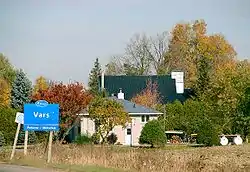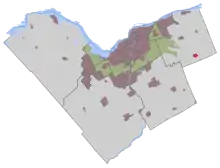Vars, Ontario
Vars is a compact rural community[1] in Cumberland Ward in the east end of Ottawa, Ontario, Canada. According to the Canada 2011 Census, the population of Vars was 1,424,[2] using the boundaries defined in the Vars neighbourhood planning study area.[3]
Vars | |
|---|---|
Community | |
 Sign seen coming in to Vars, with some properties in the background. | |
| Coordinates: 45.355946°N 75.353052°W | |
| Country | Canada |
| Province | Ontario |
| City | Ottawa |
| Founded | 1836 |
| Population (2011) | |
| • Total | 1,424 |
| Website | vars.ca |

Facilities
Vars has a French elementary school called St-Guillaume, two churches (one Anglican and one Roman Catholic), and an outdoor skating rink located in Alcide Trudeau Park. There are few businesses, including a corner store, and a pizzeria. The town's fire station, Ottawa Fire Service's Station 73, was relocated and rebuilt in 2007 and is now located at the south end of Frank Kenny Road. The local softball teams for children and teenagers, the Vars Vipers and the Vars Vikings, are sponsored by local businesses.
History
The Bearbrook area, where Vars is located, was first colonized in 1824. By 1836 a small settlement began to form. The eponymous Bear Brook originally got its name from the plentiful number of bears that foraged on acorns produced from the large quantities of oaks found alongside its sides. A Mr. Dunning set up a sawmill operation that used logs that had been channelled down through Bear Brook, and which continued on eastward to the South Nation River, the Ottawa River and finally to the St. Lawrence Seaway. Bear Brook now flows with less than half the water it did when settlers first arrived. By the time the mill was set up the town consisted of a hotel, many stores and approximately 200 people in which the vast majority were English speaking of Irish descent. In 1881, the area was named Bearbrook Station. A train station was built which would help transport logs towards the St. Lawrence. In 1886, the community reached a large enough population to gain a post office, which lightened the work load for Mr. Jack Young, who had previously brought the mail in by horse and by snowshoe in winter. Bearbrook Station was difficult to distinguish from the nearby community of Bearbrook; therefore, it was renamed to Vars. There are two stories of how Vars got its name. The first, is that with the building of the new post office, the people of Bearbrook Station decided to name the community after the four people who brought the post office to the area: Mc(V)eigh, (A)rmstrong, (R)onan, and (S)mith. The second story is that the town was given the name by a retired priest from Embrun, Abbé C. Guillame, in memory of the village of Vars, Hautes-Alpes, in France.
In 1915, permanent sidewalks were built in the main community area. In 1931, the community streets were lit up by their first street lights, one year earlier than the neighbouring community of Cumberland.
References
- http://www4.rncan.gc.ca/search-place-names/unique/FDHPX
- Population calculated by combining Dissemination Areas 35061119, 35061120 and 35061121
- http://ottawa.ca/calendar/ottawa/citycouncil/occ/2010/02-24/pec/10%20-%20ACS2010-ICS-CSS-0002%20DOCUMENT%201%20EN%20Vars.pdf
- Brault, L. 1965. Histoire des Comtés Unis de Prescott et de Russell. Conseil des Comtés Unis, L’Original, ON, CAN.
- City of Ottawa, Rural Ottawa Counts. ]http://www.ottawa.ca/city_services/statistics/counts/rural/index_en.html]
1891 Census of Canada, 1901 Census of Canada, 1911 Census of Canada.